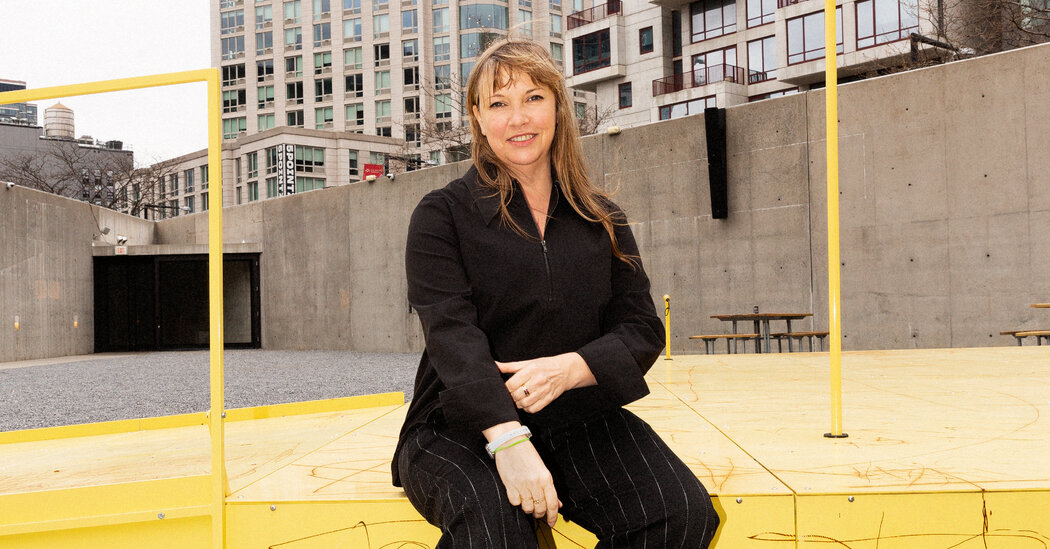
Kate Fowle, who became director of MoMA PS1 in 2019 and barely had the chance to lead the museum as a result of the Covid-19 pandemic, abruptly announced on Friday that she was stepping down as of July 15 from the museum in Long Island City, Queens.
“This has been an extraordinary opportunity to lead MoMA PS1 over the last (nearly) three years and to work with all of you alongside our Board, patrons, and funders,” she said in an email to the staff. “I want you to know that I have deep respect and admiration for you all, and that I am incredibly proud of all the work we have achieved together.”
She did not give any reasons for her departure and declined requests for comment. But one person with knowledge of the situation, who spoke on condition of anonymity because they were not authorized to speak publicly, said that Fowle recently expressed difficulty managing her job during a meeting with the museum’s chairwoman, Sarah Arison, and Glenn D. Lowry, MoMA’s director.
MoMA PS1 nevertheless proceeded with its benefit gala, which took place on May 18 and honored Agnes Gund, MoMA PS1’s former chairwoman, who continues to serve on the board of the museum and of MoMA. It was the first time the gala was held in MoMA PS1’s courtyard.
Just two months ago, in an interview with The New York Times, Fowle had outlined an ambitious plan for carving out a distinct identity for her museum, one that focused on outreach to neighboring Queens communities, emphasizing social justice issues and giving the museum a website independent of MoMA’s.
In a statement, Arison called Fowle “a talented curator and director.”
“Kate has piloted innovative models of community engagement, diversified the uses of the building and its courtyard to connect more deeply with Queens and New York communities, and strengthened PS1’s commitment and role as an artist-centric institution,” Arison added. “We all have so much admiration and respect for Kate — including her incredible work ethic and artistic vision.”
Fowle said in her staff note that she would continue to be the co-curator of an exhibition of recent work by Daniel Lind-Ramos, the Puerto Rican artist, that is scheduled to open next April “and look forward to working with you all to take that project forward.”
An interim leadership team will be led by Jose Ortiz, the deputy director; Molly Kurzius, the director of external affairs; and Ruba Katrib, a curator at the museum, under guidance from Arison and Lowry.
“I am grateful for everything she has done for MoMA PS1 and wish her great success in whatever she takes on next,” Lowry said in an email.
“She put the community and artists first,” Gund said in an interview. “She tried to make it work.”
Gund had told The Times in April that she would like to see MoMA PS1 become independent from MoMA. Fowle at the time said she did not share that view, though she disagrees with the analogy that her institution is the child and MoMA the parent. “I see the relationship from the perspective of collective impact,” she said.
But those involved with both museums say there have long been tensions between the two institutions, since MoMA is more powerful and remains in control of PS1.
MoMA’s operating budget is considerably larger — nearly $300 million — and it contributes 25 percent of PS1’s $8 million budget, including 10 percent of its operating support and 15 percent in discretionary giving from MoMA trustees and affiliate groups.
PS1 — which has focused since 1971 on experimental contemporary art — in turn provides MoMA with an added programmatic dimension.
Those who have worked closely with the British-born Fowle were taken aback by the announcement. “I’m surprised,” said Jimmy Van Bramer, the former chairman of the New York City Council’s Cultural Affairs Committee. “I thought she was a real thought leader and had done some terrific things with the museum. I’ll certainly miss her.”
Having come to MoMA PS1 from the Garage Museum of Contemporary Art in Moscow, where she was chief curator, Fowle was the first director appointed from outside the museum. Her predecessor, Klaus Biesenbach, had started as a curator there in 1995 and in 2010 took over from the museum’s founder, Alanna Heiss. Called the P. S. 1 Contemporary Art Center from its founding in 1976, the museum merged in 2000 with MoMA and changed its name in 2010 to MoMA PS1.
Fowle, who stepped into the director position just before the pandemic, had to contend with the financial losses that challenged every cultural institution during lockdown. MoMA PS1 had to reduce its staff from 64 to 17. (It subsequently went back up to 55.)
In taking the museum in a more progressive direction, Fowle was widely seen as a marked departure from Biesenbach, who gave the museum celebrity cachet.
Local activists said they appreciated MoMA PS1’s increasing openness to social causes, namely her creation of the Homeroom gallery, an exhibition space curated by community groups. Fowle also reached out to the Queensbridge Houses, the country’s largest public housing project.
She had been overseeing an effort to make the museum more physically welcoming to the community, creating a break in the exterior walls and adding amenities that will allow the courtyard to remain open when the building is closed. The city approved $9 million in capital funds last year for the project.




